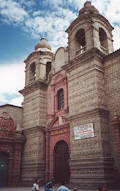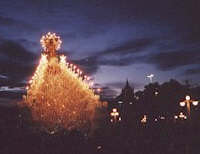Peru Travel Guide – September 2000
Ayacucho
By Iván Gallegos
Peru Travel Guide – September 2000
Ayacucho, land of warriors

Location
Central highlands at 2,761 meters above sea level.
Climate
It’s sunny during the day and cold at night (especially from June to August). The average temperature is 17.5°C. It’s rainy from November to March and the rest of the year it’s dry.
Landscape
Mostly mountains and valleys. There’s the National Reserve of Pampas Galeras where you can see the “vicuñas” (a small kind of llama with a very fine and expensive wool) in its natural habitat; there is the natural forest of Titancayoc too with the Puyas, a Peruvian cactus from the pre-historic era.
History
Ayacucho is very important in Peruvian history for many things. For example, there is the “Pikimachay” cave, home of the oldest man in South America (22,000 BC). The ruins of the capital of the ancient Wari Culture (the first empire of the Andes, before the Incas) is also in Ayacucho. And you can visit “Pampas de la Quinua”, where the Ayacucho battle took place. It sealed the independence of Peru and the retirement of the Spanish crown from the South American territories. Don’t forget to visit the different churches of Ayacucho City to appreciate the architecture of the colonial epoch and its art.
Activities
The most important festivity is celebrated at Easter. Ayacucho is very famous because of its many churches and its numerous religious feasts. It is very rich in folklore and it’s also famous for its handicrafts, its textiles, its music and dances. You can get the famous “retablos Ayacuchanos” with a regional representation of Jesus’ birth.
Easter in Ayacucho, land of faith

Peruvians are mostly Catholics. For that reason Easter is a very important feast in this country; nevertheless, Easter in Ayacucho is a breathtaking experience even for the Peruvians.
During an entire week, all regular activities in the city come to a standstill. Ayacucho becomes a city of flower-carpeted streets, solemn masses, processions and fireworks. Images depicting various scenes of the Passion of Christ emerge from the principal churches of the city. But nothing can describe the celebrations on the main days, between Easter Friday night and Easter Sunday morning.
At night on Easter Friday, a procession starts from the Sto. Domingo church (one block from the main square), first goes the image of dead Christ, and after the image of Virgin Mary, crying for her dead son. Both images go to the main square, where the lights have been turned off. The scene is breathtaking, thousands of people in darkness with burning candles in their hands, walking beside the images of Christ and the Virgin Mary. Most of the people dress in black clothes, many women cry and walk beside the crying image of Virgin Mary. The art of the flower-carpeted streets lasts only few hours, it’s a gift for Christ, a present from the faith of the people of Ayacucho.
Next Saturday night, the main square becomes a big party, with bands playing typical music on every corner, and fireworks burning everywhere. The people drink and dance because they are happy, Christ is alive again, and in few hours they will see him again walking in the main square before he goes to heaven to sit beside his father. All the people are friendly, you can make new friends easily, and get free drinks from the people dancing.
After 3 or 4 hours, the party ends, and the people wait for the Cathedral doors to open. The first mass takes place and after an hour the holy image of “Christ in the skies” goes out for an incredible procession. The sky is blue because it’s 5 am, the sun starts to shine from the mountains, and the happiness involves everyone in the main square, it’s a holy day for everyone.
Location
Peru is located on the central west coast of South America. This privileged location gives our country and amazing diversity of landscapes and environments.
The country is divided into 3 large regions: the coast (bathed by the Pacific Ocean), the Andes (with fertile valleys between snow covered peaks), and the rainforest (where the human is only a visitant).
Population & Language
Peru has a population of some 24 million inhabitants, primarily “mestizos” (mixed race). The official language is Spanish, and in the Andes regions the people speak “Quechua” (the native language) too. In the Peruvian Amazon (jungle) are another 55 languages.
Currency
Our currency is the “Nuevo Sol” (new sun) and the change rate is US$ 1.00 = S/ 3.50 nuevos soles. As a reference, you can buy a beer (350 ml. bottle) for US$1.40. Click here for a currency converter.
Entry Requirements
You don’t need to get a Visa in your country, you can enter Peru and in the airport the Immigration Office gives you immediately the TOURIST VISA for 3 months.
Only the people from African, Asian (not Japan) and some Central and South American countries need to get a Visa in a Peruvian Embassy in their countries.
Vaccination
You don’t need vaccinations to enter to Peru. However, to go to the jungle you have to get the Yellow Fever and Malaria vaccinations (you can get it in the airport). In the rest of the country only be careful with the water you drink (don’t drink non boiled water) and don’t eat mayonnaise.
Airlines Companies
From USA: American Airlines, Delta Airlines, Continental Airlines, and United Airlines.
From EUROPE: KLM, IBERIA, LUFTHANSA, British Airways, Alitalia, and AEROFLOT.
From Central and South America: LAN CHILE, AVIANCA, SERVIVENSA, LACSA, TACA, COPA, ACES, AEROPOSTAL, AEROMEXICO, AEROCONTINENTE, AerolÃneas Argentinas, LAB, VARIG, SAETA, and Cubana de Aviación.
From Asia and Oceania: QANTAS, JAL, and Singapore Airlines.
Links
For more information you can visit this web site: Indiana-Expedition.com